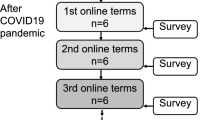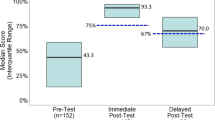Abstract
OBJECTIVE: To determine the impact of an online lecture versus a live lecture on screening given to medical students who are participating in an outpatient clerkship.
DESIGN: Prospective, randomized, controlled study.
PARTICIPANTS AND SETTING: Ninety-five senior medical students in a primary care medicine clerkship based at university and distant clinic sites.
INTERVENTION AND MEASUREMENTS: Forty-eight medical students were randomized to the live lecture on screening (live lecture group), and forty-seven medical students were randomized to the online lecture on screening (online lecture group). Outcome measures included students’ knowledge, use of time, and satisfaction with the lecture experience.
RESULTS: Compared to students in the live lecture group, students in the online lecture group demonstrated equal post-intervention knowledge of screening (P=.91) and expended 50 minutes less time to complete the lecture. Online lecture students who used the audio feed of the lecture were equally satisfied with the lecture as the live lecture students. Without the audio feed, online lecture students were less satisfied.
CONCLUSIONS: An online lecture on screening is a feasible, efficient, and effective method to teach students on outpatient clerkships about principles of screening.
Similar content being viewed by others
References
Kassirer JP. Preserving quality as the site of medical education shifts. Acad Med. 1998;73(10 suppl):120–2.
Hilger AE, Hamrick HJ, Denny FW Jr. Computer instruction in learning concepts of streptococcal pharyngitis. Arch Pediatr Adolesc Med. 1996;150:629–31.
Carr MM, Reznick RK, Brown DH. Comparison of computer-assisted instruction and seminar instruction to acquire psychomotor and cognitive knowledge of epistaxis management. Otolaryngol Head Neck Surg. 1999;121:430–4.
Pusic M, Johnson K, Duggan A. Utilization of a pediatric emergency department education computer. Arch Pediatr Adolesc Med. 2001;155:129–34.
US Preventive Services Task Force. Guide to Clinical Preventive Services. 2nd ed. Baltimore, Md: Williams and Wilkins; 1996.
Christenson J, Parrish K, Barabe S, et al. A comparison of multimedia and standard advanced cardiac life support learning. Acad Emerg Med. 1998;5:702–8.
Fincher RE, Abdulla AM, Sridharan MR, Houghton JL, Henke JS. Computer-assisted learning compared with weekly seminars for teaching fundamental electrocardiography to junior medical students. South Med J. 1988;81:1291–4.
Umble KE, Cervero RM, Yang B, Atkinson WL. Effects of traditional classroom and distance continuing education: a theory-driven evaluation of a vaccine-preventable diseases course. Amer J Public Health. 2000;90:1218–24.
Maki RH, Maki WS, Patterson M, Whittaker PD. Evaluation of a Web-based introductory psychology course: I. Learning and satisfaction in on-line versus lecture courses. Behav Res Methods Instrum Comput. 2000;32:230–9.
Rogers DA, Regehr G, Yeh KA, Howdieshell TR. Computer-assisted learning versus a lecture and feedback seminar for teaching a basic surgical technical skill. Am J Surg. 1998;175:508–10.
Bachman MW, Lua MJ, Clay DJ, Rudney JD. Comparing traditional lecture vs. computer-based instruction for oral anatomy. J Dent Educ. 1998;62:587–91.
Keane DR, Norman GR, Vickers J. The inadequacy of recent research on computer-assisted instruction. Acad Med. 1991;66:44–8.
Clark RE. Dangers in evaluation of instructional media. Acad Med. 1992;12:819–20.
Dick W, Carey L. The Systematic Design of Instruction, 4th Ed. New York: HarperCollins Publishers; 1996.
Bridges AJ, Reid JC, Cutts JH III, Hazelwood S, Sharp GC, Mitchell JA. A comparative study of computer-assisted instruction for rheumatology. Arthritis Rheum. 1993;36:577–80.
Devitt P, Worthley S, Palmer E, Cehic D. Evaluation of a computer based package on electrocardiography. Aust N Z J Med. 1998;28:432–5.
Wofford M, Spickard A III, Wofford J. The computer-based lecture. J Gen Intern Med. 2001;16:464–8.
Summers AN, Rinehart GC, Simpson D, Redlich PN. Acquisition of surgical skills: a randomized trial of didactic, videotape, and computer-based training. Surgery. 1999;126:330–6.
D’Alessandro DM, Kreiter CD, Erkonen WE, Winter RJ, Knapp HR. Longitudinal follow-up comparison of educational interventions: multimedia textbook, traditional lecture, and printed textbook. Acad Radiol. 1997;4:719–23.
Author information
Authors and Affiliations
Corresponding author
Rights and permissions
About this article
Cite this article
Spickard, A., Alrajeh, N., Cordray, D. et al. Learning about screening using an online or live lecture. J GEN INTERN MED 17, 540–545 (2002). https://doi.org/10.1046/j.1525-1497.2002.10731.x
Issue Date:
DOI: https://doi.org/10.1046/j.1525-1497.2002.10731.x




